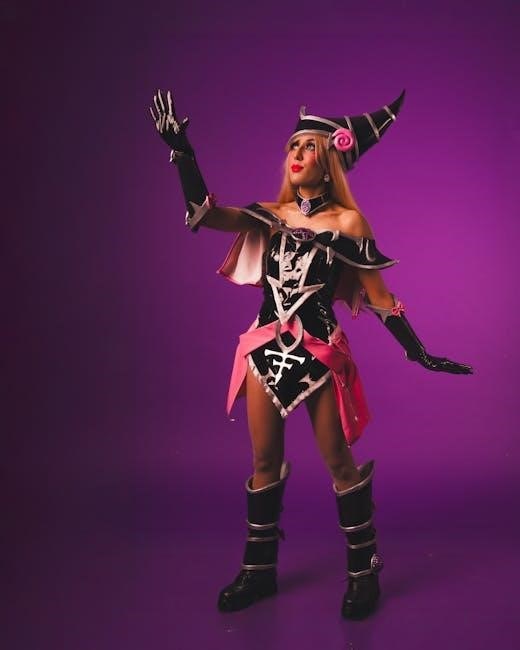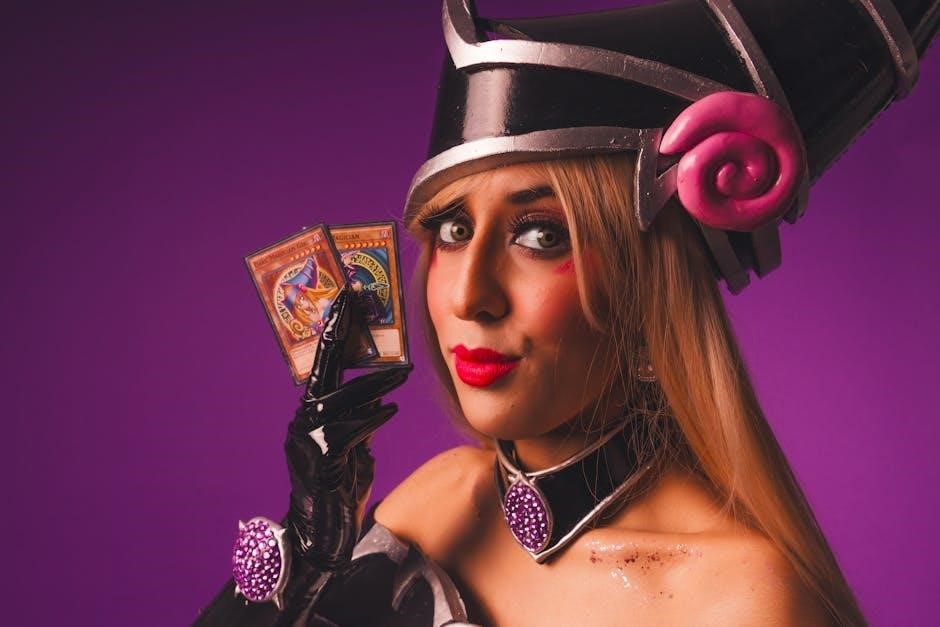Welcome to the YuGiOh Card Price Guide, your essential resource for determining the value of your cards. This guide provides insights into market trends, card rarity, condition, and demand, helping you make informed decisions when buying or selling. Whether you’re a seasoned collector or a new player, this guide offers tools to track card prices in real-time and stay updated on the latest market fluctuations.
Understanding the Basics of YuGiOh Card Values
YuGiOh card values are influenced by rarity, condition, and market demand. Common cards typically have lower value due to their abundance, while rare cards, especially in pristine condition, can command high prices. Grading systems, such as PSA, play a significant role in determining a card’s worth, with higher grades fetching premium prices. Popular cards used in competitive play or from limited editions often see increased demand, driving up their value. Tools like TCGplayer and eBay provide real-time price tracking, helping collectors and players assess their cards’ market value. Historical data also reveals trends, showing how certain cards gain or lose value over time. Understanding these factors is key to evaluating and trading YuGiOh cards effectively.
Why YuGiOh Card Prices Vary
YuGiOh card prices vary due to factors like rarity, condition, and market demand. Rare cards are scarce, increasing their value, while common cards are more affordable. Card condition, including factors like wear and tear, impacts price, with pristine cards commanding higher amounts. Market demand fluctuates based on trends, competitive play popularity, and collector interest. Professional grading services like PSA also influence value, as higher grades fetch premium prices. Additionally, supply and demand dynamics, limited editions, and promotional releases contribute to price variations, making the market dynamic and subject to change over time.
Rarity and Its Impact on Value
Rarity significantly influences the value of YuGiOh cards. Common cards are widely available and typically low in value, while Rare, Super Rare, and Ultra Rare cards are harder to find, increasing their worth. Secret Rare cards, often released in limited quantities, are highly sought after by collectors and command premium prices. The scarcity of certain rare cards, such as the Tournament Black Luster Soldier, makes them extremely valuable, with prices reaching millions. Rarity tiers directly correlate with demand, as rarer cards are often desired for competitive play or collection completion. Understanding rarity is crucial for evaluating and pricing YuGiOh cards accurately in the market.
Condition of the Card and Its Effect on Price
The condition of a YuGiOh card plays a crucial role in determining its value. Cards in pristine condition, such as “Near Mint,” command higher prices due to their flawless appearance. Conversely, cards with visible wear, creases, or damage are valued significantly lower. Grading systems, like those from the Professional Sport Authenticator (PSA), categorize cards into grades, with higher grades fetching premium prices. Even minor flaws, such as corner wear or scratches, can reduce a card’s value. For example, a “Near Mint” card might be worth 50% more than a “lightly played” version of the same card. Maintaining a card’s condition is essential for retaining its market value, especially for rare or highly sought-after cards.
Demand and Popularity in the Market
Demand and popularity significantly influence the value of YuGiOh cards. Cards that are widely used in competitive play or are part of the current meta often see increased demand, driving up their prices. Limited edition cards, promotional cards, and those featured in popular decks also experience higher demand. Conversely, cards that are less relevant to competitive play or have lower usage rates tend to be less valuable. Tools like TCGplayer and eBay provide real-time data on market trends, allowing collectors to track demand fluctuations. For example, cards like “Blue-Eyes White Dragon” remain highly sought after due to their iconic status and utility in gameplay. Popularity in media and tournaments further amplifies demand, making certain cards more valuable over time.

Understanding Card Rarity
Rarity is a key factor in determining YuGiOh card values. Common, Rare, Super Rare, Ultra Rare, and Secret Rare cards vary in supply and demand, impacting their price significantly.
Common Cards and Their Value
Common cards are the most abundant in YuGiOh sets, making them generally less valuable. Their wide availability reduces demand, often resulting in lower prices. For example, cards like Monster Reborn or Magician of Faith are highly common and typically cost between $0.50 to $2.00. However, certain common cards, especially those with meta relevance, can see slight price increases. Condition plays a significant role, with near-mint cards commanding higher prices than damaged ones. While common cards may not hold significant monetary value, they are essential for building decks. Selling common cards individually is often impractical, but bulk sales to retailers or online platforms like TCGplayer or eBay can yield modest returns. Collectors may also find value in completing sets or trading for rarer cards.
Rare Cards and Their Market Demand
Rare cards are highly sought after due to their limited supply and high demand. Cards like Blue-Eyes White Dragon or Exodia, the Forbidden One are highly valuable, especially in near-mint condition. Their demand is driven by both competitive players and collectors. The rarity symbol (a star) on the card indicates its scarcity. Professional grading services like PSA can significantly increase a card’s value, with PSA 10 grades fetching premium prices. Market demand fluctuates based on meta trends and set releases. Rare cards often serve as key investments for collectors, with certain editions, such as First Edition or Secret Rare, commanding higher prices. Their value can appreciate over time, making them a focal point for serious investors and enthusiasts in the YuGiOh community.
Super Rare and Ultra Rare Cards
Super Rare and Ultra Rare cards are highly sought after due to their limited availability and unique attributes. Super Rare cards, marked with a red “Super Rare” symbol, are rarer than Rare cards, often featuring popular or powerful characters. Ultra Rare cards, identified by a holographic foil finish, are even scarcer and typically include iconic cards like Blue-Eyes White Dragon or Exodia, the Forbidden One. These cards command high prices due to their rarity and demand. Their value is further influenced by condition, with near-mint cards fetching premium prices. Professional grading, such as PSA 10, significantly enhances their market worth. Additionally, limited print runs and special editions can drive up their demand, making them highly valuable investments for collectors and competitive players alike.
Secret Rare and Other Special Editions
Secret Rare cards are among the most exclusive and highly sought-after cards in YuGiOh. These cards feature unique holographic foil patterns and are typically released in limited quantities, making them extremely rare. Cards like the “Tyler the Great Warrior” and “Tournament Black Luster Soldier” are prime examples, with values reaching millions due to their scarcity. Special edition cards, such as promotional or anniversary releases, also hold significant value. Their exclusivity and aesthetic appeal make them highly desirable among collectors and competitive players. These cards often serve as crown jewels in collections, with their value appreciating over time. Their rarity and historical significance ensure they remain highly prized in the YuGiOh community.

Guide to Card Conditions
Card condition significantly impacts value, with factors like wear, creases, and corner damage affecting grading. Professional services like PSA evaluate cards, assigning grades that determine market worth.
Grading Systems for YuGiOh Cards
Grading systems play a crucial role in determining the value of YuGiOh cards. The most recognized grading system is provided by the Professional Sport Authenticator (PSA), which assigns grades from 1 (Poor) to 10 (Gem Mint). Cards are evaluated based on factors like corners, edges, surface, and centering. A PSA 10 grade indicates a card in pristine condition, while lower grades reflect varying degrees of wear. Graded cards are encapsulated in tamper-proof holders, ensuring authenticity and condition. This system helps collectors and sellers establish a standardized method for assessing card quality, which directly impacts market value. Higher grades typically command higher prices, making grading essential for serious collectors and investors.
Professional Sport Authenticator (PSA) Grading
Professional Sport Authenticator (PSA) grading is the industry standard for evaluating the condition and authenticity of YuGiOh cards. Cards are graded on a scale from 1 (Poor) to 10 (Gem Mint), with PSA 10 indicating a flawless card. The grading process evaluates factors such as centering, corners, edges, and surface quality. Once graded, cards are encapsulated in tamper-proof holders, verifying their condition and authenticity. PSA-graded cards often command higher prices due to their guaranteed quality. For rare cards, such as the “Tyler the Great Warrior,” PSA grading can significantly enhance their value, making them highly sought after by collectors and investors. This service ensures transparency and trust in the market, benefiting both buyers and sellers.
Impact of Card Condition on Price
The condition of a YuGiOh card significantly impacts its value. Cards in near-mint condition, with no visible wear, typically command the highest prices. Even minor flaws, such as corner wear or surface scratches, can reduce a card’s value. Graded cards, especially those graded by PSA, often sell for premium prices due to their verified condition. For example, a PSA 10 “Blue-Eyes White Dragon” can fetch thousands of dollars, while a lightly played version might sell for far less. Poor condition cards, such as those with creases or bends, are often worth only a fraction of their mint counterparts. Thus, maintaining a card’s condition is crucial for maximizing its value.
Factors Influencing Market Demand
Market demand for YuGiOh cards is influenced by factors like competitive play popularity, limited edition releases, and auction trends. These elements drive card value and collector interest.
Popularity in Competitive Play (Meta)
Popularity in competitive play significantly impacts YuGiOh card prices. Cards that dominate tournaments or are part of top-tier decks often see increased demand and higher market value. Meta-relevant cards, such as those used in championship-winning strategies, experience price surges due to their utility in high-stakes dueling. Conversely, cards that fall out of favor in competitive play may see their value decline. Rare cards with versatile effects, like “Blue-Eyes White Dragon” or “Kuriboh,” remain highly sought after due to their consistent meta relevance. This dynamic creates a fluctuating market where card values rise and fall based on their performance in competitive settings and their perceived utility among players.
Limited Edition Cards and Their Value
Limited edition YuGiOh cards often hold significant value due to their rarity and exclusive release. These cards, such as promotional or event-exclusive ones, are produced in smaller quantities, making them highly sought after by collectors. For example, the “Tournament Black Luster Soldier” is extremely rare, with only one copy in existence, and has been valued at over $2 million. Similarly, cards like “Tyler the Great Warrior” have fetched high prices due to their limited availability. Their value is further enhanced by their unique artwork or special printing, which sets them apart from standard cards. Collectors and players are willing to pay premium prices for these rare editions, driving their market demand and overall worth.
Market Trends and Card Popularity
YuGiOh card market trends are constantly evolving, influenced by competitive play, new set releases, and collector demand. Cards popular in competitive decks, such as meta-relevant ones, often see price spikes due to their utility. Limited edition cards, like “Kashtira Fenrir” and “Monster Reborn,” have experienced significant value increases recently. Real-time tracking tools, such as TCGplayer, provide up-to-date market values, showing how card popularity shifts over time. Social media and community discussions also play a role, as hype can drive demand for certain cards. Staying informed through price guides and market analysis helps collectors and players navigate these trends effectively and make informed decisions when buying or selling cards.

How to Research YuGiOh Card Prices
Use platforms like TCGplayer and eBay to track real-time card prices, or utilize historical tools for past trends. Stay updated with daily price changes and market trends.
Using TCGplayer for Price Lookup
TCGplayer is a leading platform for YuGiOh card price lookup, offering real-time market data and historical trends. Users can search for specific cards by name, set, or card number to find current market values. The platform provides detailed price tracking, including listings from various sellers, ensuring competitive pricing. TCGplayer also offers tools to filter by card condition, rarity, and edition, making it easy to find accurate valuations. Additionally, the site allows users to track price changes over time, helping collectors and sellers make informed decisions. With its comprehensive database and user-friendly interface, TCGplayer is an essential resource for anyone looking to buy, sell, or trade YuGiOh cards.
eBay and Other Auction Platforms
eBay is a popular platform for buying and selling YuGiOh cards, offering a wide range of listings from rare singles to complete sets. Auction-style listings allow buyers to bid on cards, often leading to competitive pricing. Other auction platforms, like specialized card marketplaces, also provide similar services. These sites often feature graded cards, which have been professionally authenticated and rated for condition, commanding higher prices. Sellers can list cards at fixed prices or through auctions, while buyers can filter by rarity, condition, and edition. Additionally, platforms like eBay offer buyer protection, ensuring secure transactions. Auction platforms are valuable for finding rare or hard-to-find cards, making them a key resource for collectors and traders seeking unique additions to their collections.
Price Guides and Card Databases
Price guides and card databases are essential tools for understanding the value of YuGiOh cards. Platforms like TCGplayer and Card Ladder provide comprehensive databases with real-time pricing for both graded and ungraded cards. These resources allow users to search for specific cards, view historical price trends, and compare market values across different platforms. Additionally, tools like MAVIN enable users to look up card values by entering the card number, providing detailed insights into recent sales and market demand. These databases are updated regularly, ensuring accurate and up-to-date information for collectors and traders. By leveraging these resources, individuals can make informed decisions when buying, selling, or trading YuGiOh cards, helping them maximize their collection’s value.
Historical Price Tracking Tools
Historical price tracking tools provide valuable insights into the fluctuation of YuGiOh card values over time. These tools allow users to monitor how prices have changed, identifying trends, peaks, and troughs. Platforms like Card Ladder and TCGplayer offer detailed historical data, enabling collectors and traders to analyze market behavior. By examining past pricing, users can predict future trends, make informed purchasing decisions, and identify undervalued cards. Additionally, historical data helps in understanding the impact of events, such as new set releases or changes in competitive play, on card values. This information is crucial for building and maintaining a valuable YuGiOh collection, ensuring informed decisions at every step.
Popular and Expensive YuGiOh Cards
Popular and expensive YuGiOh cards include rare editions like Tyler the Great Warrior and Tournament Black Luster Soldier, with prices reaching millions due to their uniqueness and demand.
Rarest YuGiOh Cards in Circulation
The rarest YuGiOh cards are highly sought after by collectors and players. Tyler the Great Warrior is one of the rarest, with only one copy ever printed, selling for over $311,000. Another extremely rare card is the Tournament Black Luster Soldier, valued at $2 million, due to its unique printing for a single tournament winner. Cards like these are often in near-mint condition and graded by professionals, such as PSA, to authenticate their rarity. Their limited supply and high demand make them incredibly valuable. These cards are true treasures for serious collectors and highlight the exclusive nature of certain YuGiOh releases.
Most Expensive YuGiOh Cards Ever Sold
The most expensive YuGiOh cards ever sold highlight the pinnacle of rarity and demand. Tyler the Great Warrior holds the record, selling for $311,211, with only one copy in existence. The Tournament Black Luster Soldier, valued at $2 million, is another standout, given its exclusive printing for a single tournament winner. Cards like the Blue-Eyes White Dragon in PSA 10 condition have also fetched over $1.2 million. These sales underscore the premium placed on rarity, condition, and historical significance in the YuGiOh market. Such high-value transactions demonstrate the serious investment potential for rare and graded cards among collectors and enthusiasts.
Card Collections with Increased Value
Some YuGiOh card collections have seen significant value appreciation due to rarity, demand, and market trends. Cards like Kashtira Fenrir and Monster Reborn have shown notable price increases, with values rising by over 20% in recent months. Limited edition sets and older booster packs, such as Legend of Blue Eyes White Dragon, have also gained value due to their historical significance. Additionally, certain ultra-rare cards from popular sets like Darkwing Blast have seen their prices surge. Tools like TCGplayer and historical price trackers help identify these trends, enabling collectors to monitor and capitalize on increasing card values effectively.

Buying and Selling YuGiOh Cards
TCGplayer and eBay are top platforms for buying and selling YuGiOh cards, offering real-time pricing and auction options. Use price guides and tracking tools to stay updated on market trends and ensure fair deals.
Where to Buy Rare YuGiOh Cards
To find rare YuGiOh cards, TCGplayer and eBay are top choices, offering extensive listings and real-time pricing. Specialized card shops and online marketplaces like Card Kingdom or CoolStuffInc also carry rare cards. For graded cards, consider PSA-graded options on eBay or through professional sellers. Additionally, local card shops and conventions can be great sources for rare finds. Always compare prices across platforms and check seller ratings for reliability. Platforms like Facebook Marketplace or Discord communities may also have rare cards, but ensure authenticity before purchasing. Use tools like TCGplayer’s price guide to negotiate fair deals and avoid overpaying. Explore these options to build or enhance your collection effectively.
How to Sell Your YuGiOh Cards
To sell your YuGiOh cards effectively, start by researching their value using price guides like TCGplayer or eBay. Grade your rare cards through PSA for higher market value. List your cards on platforms like TCGplayer, eBay, or specialized card shops for quick sales. Auction sites may yield better prices for rare or high-demand cards. Consider selling to local card shops or at conventions for in-person deals. Use high-quality photos and detailed descriptions to attract buyers. For bulk sales, platforms like Facebook Marketplace or Discord communities can connect you with collectors. Stay updated on market trends and timing to maximize your profits. Professional grading and accurate pricing are key to successful sales.
Negotiating Prices and Trade Practices
Negotiating YuGiOh card prices requires transparency and understanding of market values. Research your cards using platforms like TCGplayer or eBay to ensure fair pricing. When trading, agree on terms beforehand, including card conditions and equivalencies. Use professional grading services like PSA to verify card authenticity and condition, boosting credibility. Trade platforms like Facebook Marketplace or Discord communities connect buyers and sellers directly. Be flexible but firm in negotiations, and consider offering bulk deals for multiple cards. Always verify the legitimacy of trades and payments to avoid disputes. Clear communication and mutual respect are key to successful transactions. Stay informed about market trends to make informed decisions during negotiations.

Current Trends and Future Predictions
YuGiOh card prices are rising due to increased demand for rare and limited-edition cards. Market trends show growing interest in vintage and high-grade cards, with future predictions indicating continued growth in value for rare and unique cards.
Recent Trends in YuGiOh Card Market
Recent trends in the YuGiOh card market show a significant surge in prices for rare and limited-edition cards, particularly those in pristine condition. Auction platforms like eBay have reported record-breaking sales, with cards such as the Tyler the Great Warrior selling for over $300,000. The demand for professionally graded cards, especially PSA 10s, has increased, driving up their value. Additionally, the rise of competitive play and the introduction of new meta decks have further fueled the demand for specific cards. Limited edition releases and special promotions are also influencing market trends, creating a dynamic environment for collectors and players, with growth expected to continue.
Future Predictions for Card Values
The future of YuGiOh card values is expected to see continued growth, driven by increasing demand for rare and limited-edition cards. Ultra-rare and professionally graded cards, such as PSA 10s, are likely to appreciate significantly, especially if their condition remains pristine. The global expansion of the YuGiOh player base, particularly in emerging markets, could further boost prices. Additionally, the release of new sets and the potential for reprints may influence availability and value. Cards tied to competitive play and meta decks are expected to remain in high demand, while limited editions and promotional cards may see increased value due to their scarcity. Overall, the market is poised for sustained growth, with rare cards leading the way.